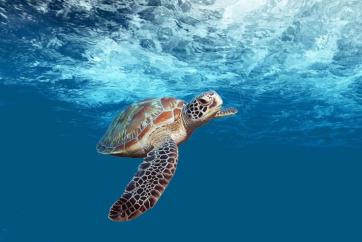In addition to the challenge of promoting an ecosystem-based marine governance is the task of agreeing on an international regulatory framework to promote the conservation and sustainable use of biodiversity in areas beyond national jurisdictions (ABNJs). ABNJs, which account for almost half of the Earth's surface and 64 per cent of the oceans, need to be granted a protection regime that is appropriate to their nature.
The MarViva Foundation, with the support of IUCN and other international organizations, has focused on leading the discussion in the region and, since 2012, has promoted the Thermal Dome Initiative through permanent processes of knowledge generation and management, as well as political and media advocacy.
The Thermal Dome is an upwelling area located west of the Central American coast, in the Eastern Tropical Pacific. It is generated by the dynamics between winds and sea currents that vertically move deep, cold and nutrient-rich water to the surface. This results in a concentration of phytoplankton, attracting a large number of fish, marine mammals and other organisms. However, this is a permanent but dynamic phenomenon: its core is located in the high seas, near 9º North and 90º West, and its extension is fluctuating, ranging from 300 to 1,000 kilometres wide.
Promoting the conservation and sustainable use of the Thermal Dome is crucial. Species such as sharks, turtles, dolphins, whales and commercial fish benefit from the richness of nutrients in the waters of the Dome. The protection of this area is essential for its survival, but it is also critical for the economy of the surrounding coasts, which depend on commercial activities linked to these species, such as fishing and tourism.
To do this, we not only need to generate more and better scientific information, but also to achieve an institutional platform and the commitment to assume and lead the technical and political processes needed for the Thermal Dome to become the first managed ABNJ site in the Eastern Tropical Pacific.
MarViva found an ally in the Central American Commission for the Environment and Development (CCAD), an organ of the Central American Integration System (SICA) in charge of developing a regional environmental cooperation and integration regime. With the technical advice of the foundation and the financial support of the Global Ocean Biodiversity Initiative, CCAD has recognized the biological, environmental and social relevance of the Thermal Dome, leading to the inclusion of the Thermal Dome Initiative in the regional environmental agenda by the Council of Ministers of the eight Member States (Guatemala, Belize, Honduras, El Salvador, Nicaragua, Costa Rica, Panama and the Dominican Republic) in 2013, an agreement subsequently reconfirmed in 2019, when the elaboration of a specific work plan was agreed. This plan will be implemented from 2021 with the support of the French Fund for the Global Environment and the CCAD governments and Technical Secretariat, with the intention of culminating in the multisectoral generation of a hybrid and participatory governance model for the ABNJ of the Thermal Dome.
MarViva would like to thank the SICA government authorities, and more particularly their representations to the CCAD, as well as IUCN and all international and regional alliances that have provided their technical and financial support to the Thermal Dome Initiative, through which significant progress has been made, from Central America, to address the global challenges of marine governance.
We hope that this regional governance model for the Dome will soon be consolidated, ensuring the protection of the resources located in the region of this extraordinary oceanographic phenomenon.
About the Author

MarViva Foundation
A non-governmental and non-profit organization that works for the conservation and sustainable use of marine and coastal resources, MarViva operates regionally, facilitating multisectoral processes for the planning, creation and participatory governance of Marine Protected Areas (MPAs) in Costa Rica, Panama and Colombia.





